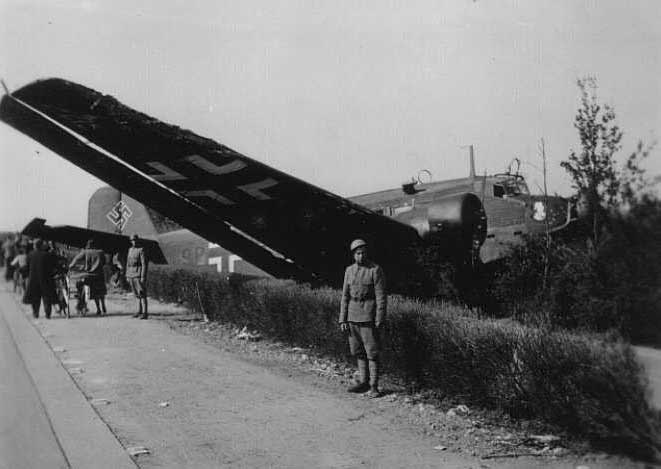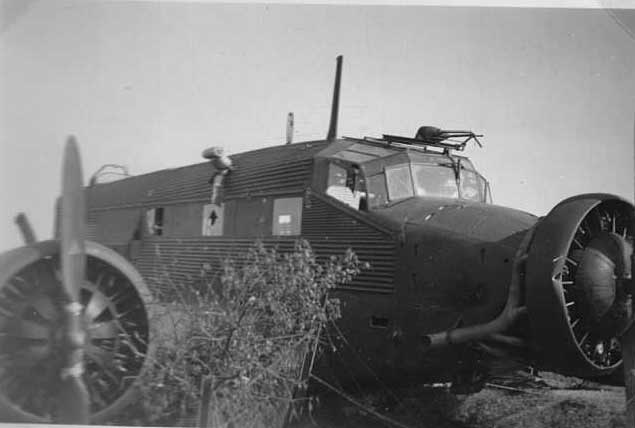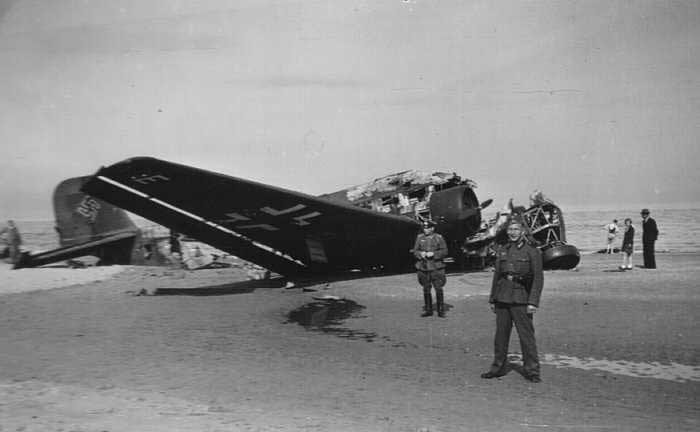|
22. (LL)
Infanterie-Division

1935: Aufstellung
am 15.10.1935 in Bremen.
1939:
Polenfeldzug: Das verstärkte IR 16
nimmt an der Schlacht an der Bzura teil.
Westen: Der Rest der Division sichert
die Westgrenze in der Eifel.
1940:
Teilnahme am Westfeldzug.
Luftlandeeinsätze in Holland, bei Rotterdam, Valkenburg und Den Haag. Anfang
Juni Vormarsch über Dinant auf St.Quentin.
1941:
Teilnahme am Rußlandfeldzug im Rahmen
der 11.Armee. Bereitstellung in Rumänien. Angriff über den Pruth zum Dnjestr.
Durchbruch durch die Stalinlinie und Erkämpfung des Dnjepr-Übergang bei Berislaw.
Vormarsch durch die Nogaischen Steppe und Durchbruch auf die Krim. Kämpfe im
Jaila-Gebirge und um die Festung Sewastopol
1942:
Teilnahme am Rußlandfeldzug im Rahmen
der 11.Armee: Belagerung und Eroberung von Sewastopol.
Verlegung auf Kreta.
Sicherungsaufgaben auf den Insel.
1944:
Einsatz im Ägaischen Raum: Besetzung
der Insel Kos, Kalymnos und Samos. Verlegung der Division auf das Festland im
Oktober. Kämpfe am Furka-Paß, Larissa, bei Skoplje. Rückzug über das Amselfeld
nach Sarajewo.
1945:
Rückzug über Visegrad zur Save.
Abwehrkampf zwischen Drau und Save. Weiterer Rückzug in den Raum Cilli. Hier
kommt die Division in jugoslawische Gefangenschaft.
Divisionskommandeure:
 Generalleutnant Hans Graf von Sponeck
Generalleutnant Hans Graf von Sponeck
- seit Aufstellung Generalleutnant Hans Graf von Sponeck
- 10. Oktober 1941 General der Infanterie Ludwig Wolff
- 1. August 1942 General der Infanterie Friedrich-Wilhelm
Müller
- 15. Februar 1944 Generalmajor Heinrich Kreipe
Gliederung:
|
1940
|
Infanterie-Regiment 16
Infanterie-Regiment 47
Infanterie-Regiment 65
Artillerie-Regiment 22
I./Artillerie-Regiment 58
Aufklärungs-Abteilung 122
Panzerjäger-Abteilung 22
Pionier-Bataillon 22
Nachrichten-Abteilung 22
Sanitäts-Abteilung 22
Feldersatz-Bataillon 22 |
Der Einsatz
der 22. Infanterie-Division 1940 gegen die "Festung Holland" bei
bei Rotterdam, Valkenburg und Den Haag
gilt als die erste Luftlandung
hinter der gegnerischen Front in der Kriegsgeschichte. Das
Infanterie-Regiment 47 und Infanterie-Regiment 65
wurden nördlich von Rotterdam (Valkenburg, Ockenburg, Ypenburg) eingesetzt. Das
Infanterie-Regiment 16 südlich von Rotterdam, bei Waalhaven.
In den Niederlanden springt das III. Bataillon des
Fallschirmjägerregiments 1 (Hpm. Schulz) über Waalhaven ab und erobert zusammen
mit dem III. Bataillon des I.R. 16 (v. Choltiz) den zäh verteidigten Flugplatz.
Auch über Moerdijk und Dordrecht springen die Jäger ins feindliche Feuer. In
Rotterdam besetzten 120 Soldaten (Pionier-Bataillon
22 und 11.Kompanie/Infanterie-Regiment 16, als Kampfgruppe Schrader)
mit 12 Seeflugzeugen He59 drei wichtige Brücken. Die
Einsätze bei Maastricht und Kanne, Den Haag, Ypenburg und Ockenburg scheitern.
Die Luftlandetruppe des Heeres (22. I.D.) erleidet durch niederländische Jäger
und Flak hohe blutige Verluste, wird zersprengt und isoliert. Trotz der
kritischen Lage in Holland kämpfen die deutschen Luftlandetruppen erbittert
weiter. 120 Mann einer Kampfgruppe
und 50 Fallschirmjäger halten den Platz Waalhaven,
gegen holländischen Widerstand, aber bei hohen Verlusten. Die isolierte 22. I.D.
und die in Rotterdam gelandeten Soldaten leisten verbissen Widerstand und halten
bis zum Eintreffen der eigenen Truppen stand. Die in die Stadt einrückenden
Truppen hatten örtlichen Widerstand der Holländer mit heftigem Gegenfeuer
beantwortet. Am 15. Mai 1940 kapitulierten die Holländer.
The 22.Infanterie-Division
(Luftlande) took part in the Western Campaign in 1940 in its intended airlanding
role when the division was flown into Holland in the early hours of May 10th in
the van of the attack on the low countries following the airbone assault of the
7.Flieger-Division. Infanterie-Regiment 47 and Infanterie-Regiment 65 were flown
in Ju52 transport aircraft to three landing zones north of Rotterdam in the
Hague region, while Infanterie-Regiment 16 was flown south into the Rotterdam
region. Attempts were made to land portions of Infanterie-Regiment 47 and
Infanterie-Regiment 65 in or around Valkenburg, Ockenburg and Ypenburg with
varying degrees of success. At each location a combination of factors led to
very heavy losses, including terrible coordination, Dutch resistance and
horrible landing zones. This in turn led to a failure to reach the objectives of
the first day, the securing of the airfields around the Hague and the capture of
the Dutch high command and Royal family who managed to escape to England.
To the south, Infanterie-Regiment 16 had a much better time of the landings
managing to secure the airfield at Waalhaven rather soon after landing, although
Dutch resistance made the landing zone dangerous for sometime. Once landed, the
bulk of Infanterie-Regiment 16 was directed to march north and capture Rotterdam
itself. To facilitate such a bold attack, an even bolder one was planned - the
capture of the bridges over the Maas River in the very center of Rotterdam. Four
bridges in the center of town connected the northern and southern portions of
the city between the Maas and the island of Noordereiland. Their importance was
that they were vital if Infanterie-Regiment 16 was to take Rotterdam at all. To
capture them, 120 men of Pionier-Bataillon 22 and
11.Kompanie/Infanterie-Regiment 16 were formed into Kampfgruppe Schrader and
flown to the base of the four bridges in He59 float planes. Their bold assault
was a stunning success and they managed to seize the bridges without any losses.
Their small numbers meant they would be under severe pressure from any Dutch
counterattacks. Soon after the Kampfgruppe occupied the bridges they linked up
with Fallschrimjäger that had dropped to assist. Dutch attacks began thereafter
and constricted the German permitter to the base of the bridges, prohibiting
them from expanding their hold farther to the north. The 120 men of the
Kampfgruppe and the 50 Fallschirmjäger held out until those landed at Waalhaven
could link up. In the meantime the Dutch responded by attacking the bridges from
the air and water, including an attack by Dutch naval vessels at point blank
range. Dutch gunboat Z-5 and torpedo boat TM-51 were sent in to rake the Germans
with 75mm and 20mm fire. In the end, the landings in the north proved to be a
failure and the scattered and uncoordinated troops were ordered to head south
once it was clear the Hague would not be taken. In the south the Dutch withdrew
on May 13th once it was clear that the Germans could not be defeated.
During the second phase of the Western Campaign in June of 1940, the
22.Infanterie-Division (Luftlande), now regrouped and refreshed, took part in
the advance into France fighting in the region of Dinant and Recroi to Saint
Quentin.



zum Seitenanfang
| 